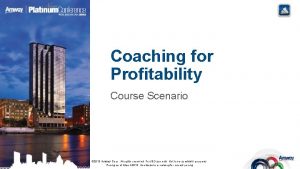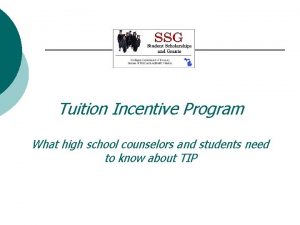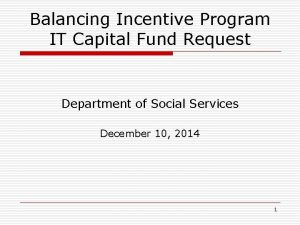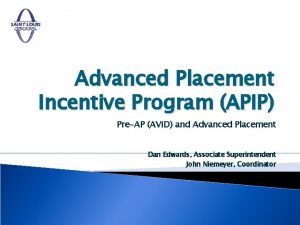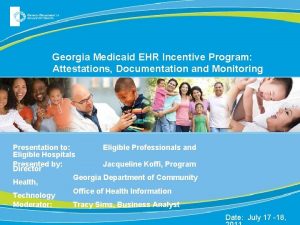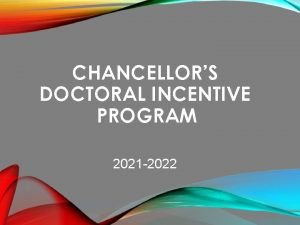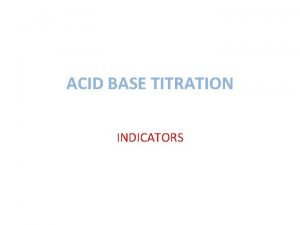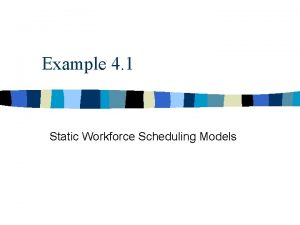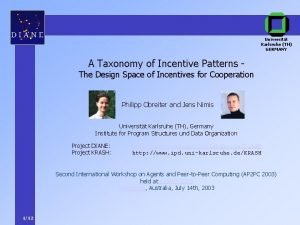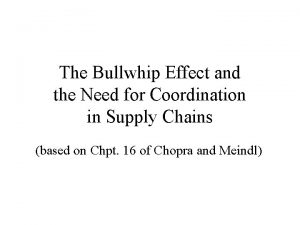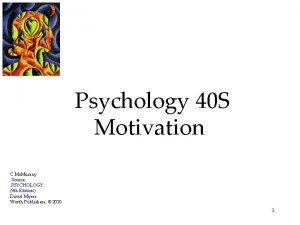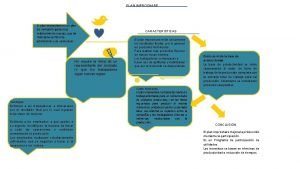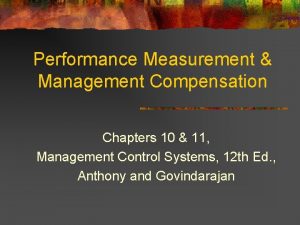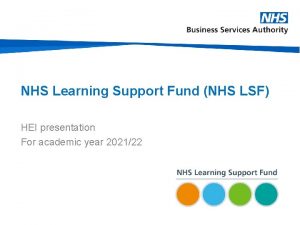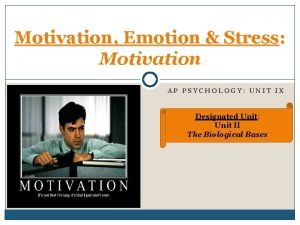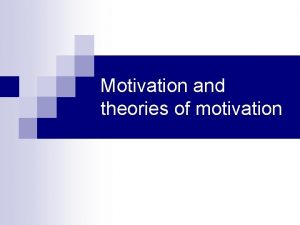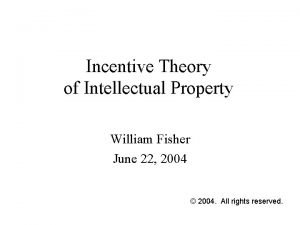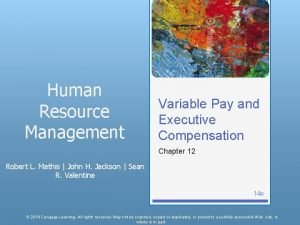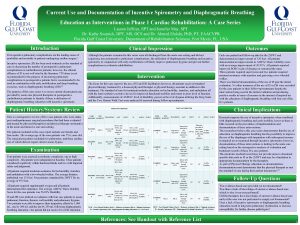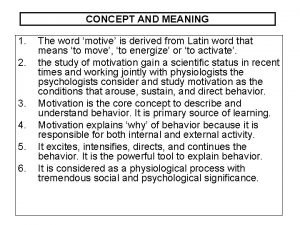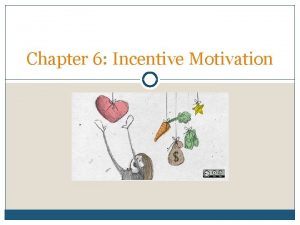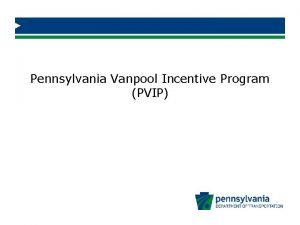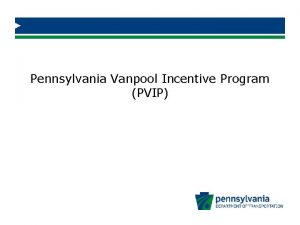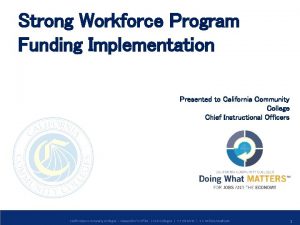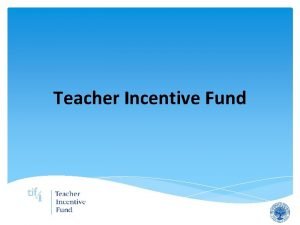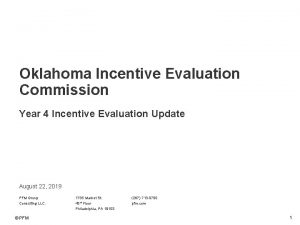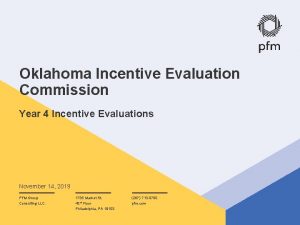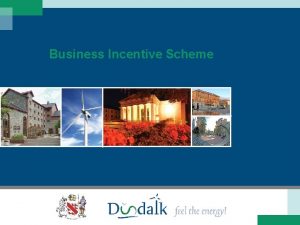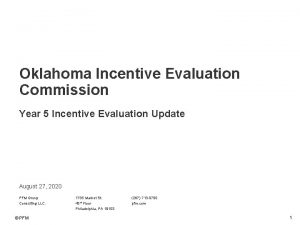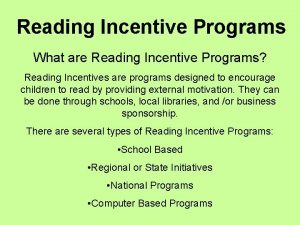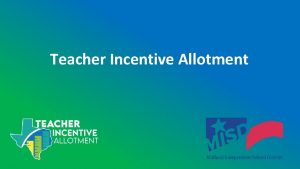Strong Workforce Program Incentive Funding Model Strong Workforce




































- Slides: 36

Strong Workforce Program Incentive Funding Model

Strong Workforce Program Funding • • $200 million in annual CTE funding Focused on expanding and improving CTE programs through regional collaboration and by preparing more students for high-demand, highwage jobs Aim to fill the gap of 1 million people trained for middle-skills jobs 60% of funds go to districts, 40% of funds go to regions (after 5% goes to state leadership) doingwhatmatters. cccco. edu 2

Strong Workforce Program Funding The legislation requires that funding be allocated in the following way, starting in 2017 -18: CTE FTES; 33% Unemploymen t Rate; 33% Student Outcomes; 17% Job Openings; 17% doingwhatmatters. cccco. edu 3

Strong Workforce Program Incentive Funding Model Developed with input from the 17% Committee, which is composed of practitioners and other experts doingwhatmatters. cccco. edu 4

Strong Workforce Program Incentive Funding Model • Leveraged research from other states that have implemented incentive funding models • Tested through extensive data modeling involving all California community colleges and regions doingwhatmatters. cccco. edu 5

How will SWP incentive funding impact California community colleges? doingwhatmatters. cccco. edu 6

Designed to reward Strong Workforce Program values • • • Improve student outcomes, focused on completion, employment, and earnings Students leave community college with the skills employers need Alignment of programs and curriculum with regional labor market demand Shifts in overall college investments Long-term investments Calculated risks to drive innovation Deliberate, thoughtful actions Continuous improvement Rewards over punishments Collaboration over competition Maximum flexibility and local decision-making doingwhatmatters. cccco. edu 7

Funding for every student with a positive outcome • • Using a points system, colleges and regions will receive incentive funding for every CTE student who makes progress toward completion, earns a certificate or degree, transfers to a four-year institution, secures employment, or attains positive earnings outcomes Colleges and regions will receive incentive funding at a 50% higher rate for economically disadvantaged students who attain the Strong Workforce Program metrics doingwhatmatters. cccco. edu 8

Measures results for all CTE programs • Local outcomes will be tracked for all CTE students within college districts, regardless of specific program, to incentivize strong overall CTE portfolios • Regional outcomes will be tracked for all CTE students at every college in the region to encourage collaboration across institutions doingwhatmatters. cccco. edu 9

Additional funding for all colleges and regions • In modeling conducted for all colleges and regions based on prior outcomes, all received incentive funding and about half received more funds than the first SWP year, when student outcomes were not included • No bias was found in the model toward specific types of colleges based on location, size, scale of CTE offerings, and type of students served doingwhatmatters. cccco. edu 10

Transparency and accountability • • • Annual progress will be made visible on the Launch. Board Strong Workforce Program tab Colleges and regions will update their plans each year to ensure that investments help students attain the Strong Workforce Program outcomes Colleges and regions will use labor market information and set nonbinding projections for program-level outcomes as part of the planning process doingwhatmatters. cccco. edu 11

Highlights promising practices • The Chancellor’s Office will issue the annual CTE Stars awards to highlight programs that are generating economic mobility for their students • Colleges will receive support from the Chancellor’s Office to communicate their outcomes and effective practices to students, colleges, employers, and their communities doingwhatmatters. cccco. edu 12

Promotes longer-term investments Pending approval by the legislature—decision by July 2017 • • Funding levels will be held constant for four years, with both the 17% incentive funds and the 83% of funds that are based on CTE FTES, unemployment, and job openings being adjusted on the same cycle Student outcomes will be tracked over a three-year period, followed by a planning year, before incentive funds are recalculated doingwhatmatters. cccco. edu 13

How will the SWP incentive funding be implemented? doingwhatmatters. cccco. edu 14

Phase In of the SWP Incentive Model: 2016 -17 Funds • Colleges received 17% of SWP funds based on the same allocation model as the 83% (which emphasized enrollments) • Colleges and regions will have through 2018 -19 to expend funds, based on the plans submitted in January 2017 • Colleges and regions can amend their plans anytime before July 1, 2017 • Plans can be amended in a new, easier-to-use web interface starting in mid-May doingwhatmatters. cccco. edu 15

Phase In of the SWP Incentive Model: 2017 -18 Confirmed • The 83% funds will remain the same as in 2016 -17 • The 17% incentive funding will be based on course enrollments and students who earned a degree or certificate in 2016 -17 Pending approval by the legislature—decision by July 2017 • Colleges and regions will receive the same funding amount in all four years of the plan period (2017 -18 through 2020 -21) doingwhatmatters. cccco. edu 16

Phase In of the SWP Incentive Model: 2021 -22 through 2024 -25 Pending approval by the legislature—decision by July 2017 Allocations will be recalculated in fall 2020, to inform funding starting in 2021 -22, including: • • CTE FTES Regional unemployment Job openings Student outcomes on ten metrics, measured during 2017 -18, 2018 -19, and 2019 -20 Colleges and regions will receive the same funding amount in all four years of the plan period doingwhatmatters. cccco. edu 17

December 2017 July 2017 Timeline: Funding Distributions All 2017 -18 funds can be spent retroactive to July 1 83% funds distributed to regions and districts doingwhatmatters. cccco. edu 18 17% allocations announced, based on course enrollments & awards in 2016 -17 17% funds distributed to regions and districts

Timeline: Planning for Round Two June 1, 2018 March 31, 2018 Pending approval by the legislature—decision by July 2017 Regional plans due for the four year period of 2017 -18 through 2020 -21 doingwhatmatters. cccco. edu 19 Local plans due for the four year period of 2017 -18 through 2020 -21

Student outcomes posted for the prior academic year for all metrics June December Timeline: Annual Updates doingwhatmatters. cccco. edu 20 Annual updates due to regional and local plans Updates should address student attainment of all metrics

Timeline: Planning for Round Three • • CTE FTES unemployment job openings SWP metrics for 2017 -2020 Regional plans due for the four year period of 2021 -22 through 2024 -25 doingwhatmatters. cccco. edu 21 June 1, 2021 Revised allocations posted based on: March 31, 2021 December 2020 Pending approval by the legislature—decision by July 2017 Local plans due for the four year period of 2021 -22 through 2024 -25

What will the SWP incentive funding model measure? doingwhatmatters. cccco. edu 22

Adjustments to the Strong Workforce Program Metrics Starting in 2017 -18, course enrollments will no longer be part of the metrics. Instead, two new federally-aligned skillsgains metrics will be added: • • the number of students who attained 12 credit units in CTE the number of students who attained 48 noncredit CTE instructional contact hours doingwhatmatters. cccco. edu 23

Strong Workforce Program Metric List Progress • • the number of students who attained 12 credit units in CTE the number of students who attained 48 noncredit CTE instructional contact hours the number of students who earned a locally-issued certificate, Chancellor’s Office approved certificate, or degree The number of students who transferred to a four-year institution doingwhatmatters. cccco. edu 24

Strong Workforce Program Metric List Employment • • • the number of CTE students who were employed in the second fiscal quarter after exiting the community college system the number of CTE students who were employed in the fourth fiscal quarter after exiting the community college system the rate at which CTE students report they were employed in a job closely related to their field of study doingwhatmatters. cccco. edu 25

Strong Workforce Program Metric List Earnings • • • the median earnings in the second fiscal quarter among CTE students who exited the community college system the number of CTE students who exited the community college system and improved their earnings the number of CTE students who earned a certificate or degree, or were identified as skills-builder students, who attained the regional living wage doingwhatmatters. cccco. edu 26

Getting Credit for Student Outcomes The SWP incentive funding levels are based on: • Data reported to the Chancellor’s Office through MIS • Employment data gathered by the state of California • The CTE Outcomes Survey Colleges do not need to track student outcomes on their own. doingwhatmatters. cccco. edu 27

Getting Credit for Student Outcomes To get full credit for your students’ outcomes: • • • Report all types of certificates and degrees to the Chancellor’s Office by October 1 Report all of the data elements necessary to calculate the Perkins definition of economically disadvantaged students by October 1 Participate in the CTE Outcomes Survey each year (costs covered by the Chancellor’s Office) and help to maximize student responses doingwhatmatters. cccco. edu 28

How will the SWP incentive funding allocations be calculated? doingwhatmatters. cccco. edu 29

Allocation of Points For almost all metrics, one point is awarded for each student who attains the measure. If 100 students transfer, 100 points will be awarded. If 450 students are employed in the second fiscal quarter after exit, an additional 450 points will be awarded. doingwhatmatters. cccco. edu 30

Allocation of Points Some measures have different point totals: • Progress: 0. 5 point for attaining 12 credit CTE units or 48 noncredit CTE instructional contact hours for the first time • Completion: 1 point for a credit certificate under 18 units or a noncredit certificate of 48 -288 hours, 2 points for a credit certificate of 18 -30 units or a noncredit certificate of over 288 hours, 3 points for a credit certificate of over 30 units or a degree • Employment in field of study: multiplies the rate at which students reported being employed in their field of study by the number of students in the CTE Outcomes Survey sample • Earnings in the second quarter after exit: divides the dollar value by ten to bring figures in alignment with other metrics doingwhatmatters. cccco. edu 31

Extra Points for Economically Disadvantaged Students When an economically disadvantaged student (using the Perkins definition) attains a metric, the college will earn 50% more points for that metric. If 50 of the 100 students who increased their earnings were economically disadvantaged, 125 points will be awarded. doingwhatmatters. cccco. edu 32

Local Share Formula • Points for all CTE programs at all community colleges are totaled • This statewide figure is divided by the amount of funding available for the 17% local share to create a value per point • Then the value per point is multiplied by the number of points that each college received to determine its distribution doingwhatmatters. cccco. edu 33

Regional Share Formula • Points for all CTE programs are totaled at the regional level and added together to create a statewide total • This statewide figure is divided by the amount of funding available for the 17% regional share to create a value per point • Then the value per point is multiplied by the number of points that each region received to determine its distribution doingwhatmatters. cccco. edu 34

Where can I find more information about the SWP incentive funds? doingwhatmatters. cccco. edu 35

• Access this presentation, an infographic, and a full description of the funding model • Read the white papers that informed model development • Give your feedback doingwhatmatters. cccco. edu 36
 Ephesians 6 10-20 nkjv
Ephesians 6 10-20 nkjv Amway platinum structure
Amway platinum structure Indian incentive program
Indian incentive program Aka.ms/partnerincentives
Aka.ms/partnerincentives Partner incentive program microsoft
Partner incentive program microsoft Michigan tuition incentive program
Michigan tuition incentive program Balancing incentive program
Balancing incentive program Advanced placement incentive program
Advanced placement incentive program Ny medicaid ehr incentive program
Ny medicaid ehr incentive program Csu doctoral incentive program
Csu doctoral incentive program Verizon volunteer incentive program
Verizon volunteer incentive program Unlimited funding
Unlimited funding Product funding model
Product funding model Strong vs weak base
Strong vs weak base Strong acid strong base titration curve
Strong acid strong base titration curve How to remember strong acids and strong bases
How to remember strong acids and strong bases Weak acid and strong base titration curve
Weak acid and strong base titration curve Strong and weak bases
Strong and weak bases Acid base neutralization reaction
Acid base neutralization reaction Pcmm training
Pcmm training Strategic workforce planning swp
Strategic workforce planning swp Workforce scheduling model
Workforce scheduling model Incentive karlsruhe
Incentive karlsruhe Behavioral obstacles in supply chain
Behavioral obstacles in supply chain Arousal theory
Arousal theory Improshare plan
Improshare plan Long-term incentive plan examples
Long-term incentive plan examples Nhs student learning support fund
Nhs student learning support fund Arousal theory
Arousal theory Arousal theory of motivation definition
Arousal theory of motivation definition Stimulus motives examples
Stimulus motives examples Incentive theory
Incentive theory Incentive organization
Incentive organization Microsoft partner incentives fy21
Microsoft partner incentives fy21 Thouraya abdellatif
Thouraya abdellatif Incentive spirometer documentation
Incentive spirometer documentation Incentive theory meaning
Incentive theory meaning

